Order Passeriformes | Phylum Chordata Family Meliphagidae Scientific name Lichenostomus flavicollis Rank Species | |
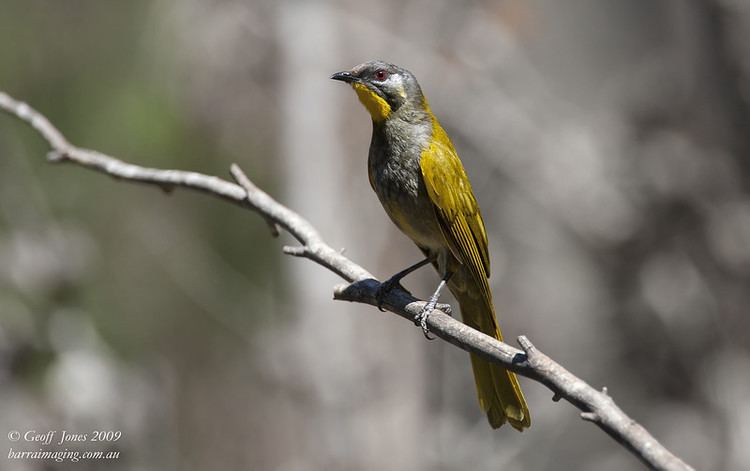 | ||
Similar Strong‑billed honeyeater, Black‑headed honeyeater, Honeyeater, Bird, Yellow wattlebird | ||
The yellow-throated honeyeater (Nesoptilotis flavicollis), also known as the green cherry-picker, green dick or green linnet is a species of bird in the family Meliphagidae. It is similar in behaviour and appearance to the white-eared honeyeater and is endemic to Australia's island state of Tasmania. It was formerly considered a pest of orchards.
Contents

Taxonomy
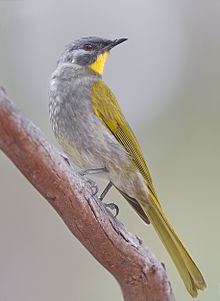
The species was originally described by French ornithologist Louis Jean Pierre Vieillot in 1817, who originally placed it in the genus Melithreptus. Its specific epithet is derived from the Latin words flavus "yellow", and collis "neck". Other vernacular names are the green cherry-picker, green dick or green linnet.

The yellow-throated honeyeater was previously placed in the genus Lichenostomus but was moved to Nesoptilotis after a molecular phylogenetic analysis published in 2011 showed that the original genus was polyphyletic. It is a sister taxon to the white-eared honeyeater (N. leucotis) that occurs in Tasmania. The two are part of a clade that contains the genera Entomyzon, Melithreptus and Foulehaio.
Description
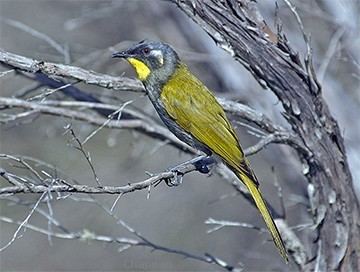
The yellow-throated honeyeater is a medium-sized honeyeater with a relatively long tail. Typical weight is 31 g and the average length is 21 cm. The plumage is bright olive green above, with a silver-grey crown, face, and underbelly contrasting with a distinctive bright yellow chin and throat. There is a small yellow ear-patch and the wing feathers are outlined with yellow. The bill is black and the eye is a deep ruby red. Females are smaller than males. Juvenile birds are very similar to adults, but duller.
Distribution and habitat
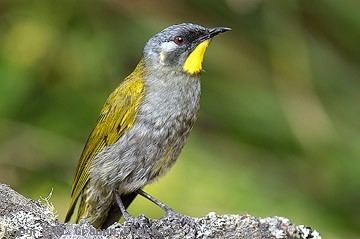
The yellow-throated honeyeater is common and widespread on the mainland of Tasmania, King Island and the Furneaux Group. The species is common and widespread, and is not considered threatened.
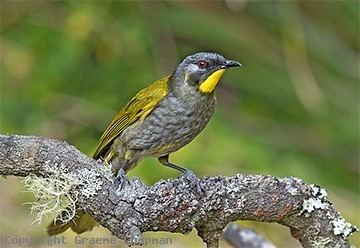
Its natural habitat is temperate forests, woodlands and coastal scrub and heath. Both wet and dry sclerophyll forests are the preferred habitats, with other habitats like alpine eucalypt woodland and open eucalypt woodland, cool rainforest, coastal heathlands, and shrublands also being used. They may also be found in golf courses, orchards, parks and gardens. Older stands of Dry Sclerophyll may be adversely affected by fire.
Behaviour
The yellow-throated honeyeater is territorial and quite aggressive towards other honeyeaters, pardalotes, golden whistlers and grey shrike-thrushes and will chase them away from their territories.
Feeding
The yellow-throated honeyeater feeds mainly on arthropods, also taking some nectar, and occasionally feeds on fruit or seeds. The species forages from the canopy down to the ground, usually singly or in pairs. Food is obtained by gleaning from trunks, branches and the ground, by probing between loose bark and the trunks and by occasional sallying flights. More rarely flowers are investigated for insects and occasionally nectar.
Breeding
Breeding occurs from August to January. During breeding season females move into male territories. The nest is often within 1 m of the ground in a low bush or tussock, but may occasionally be found at up to 10 m in foliage. It is constructed by the female from grass, bark-shreds, leaves and spiders' web and lined with treefern fibres, wool and fur. This species is known for collecting nest hair from live animals such as horses, dogs and humans. The female incubates the eggs and feeds the young. A typical clutch is two or three pinkish eggs and the incubation period is approximately 16 days. The female alone incubates the eggs, and also feeds the nestlings. Hatchings also spend around 16 days in the nest. The male will drive off the fledglings and the female when they are old enough to disperse (usually at around three weeks). This species is parasitised by the fan-tailed cuckoo and the pallid cuckoo.
Calls
The yellow-throated honeyeater makes a variety of calls. These include a breeding call, used for attracting mates and to advertise ownership of a territory. That call varies geographically but essentially consists of a whirring chur-uk, chur-uk or a loud de-wit and is used during breeding season. Another common call is a repeated tonk, tonk, tonk or tchook, tchook.
